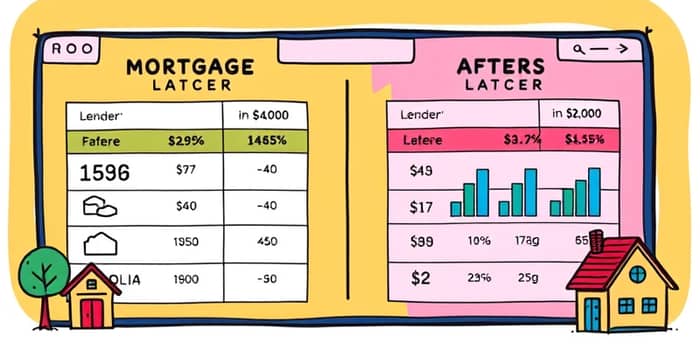Securing a home loan can feel overwhelming, especially with countless lenders and varying rates. Thankfully, built-in tools for transparent comparison streamline this process, helping you find the mortgage that fits your needs.
By leveraging online platforms that aggregate offers, you can confidently move forward, armed with data and clarity. This guide dives deep into every aspect of applying for a mortgage with built-in rate comparison tools, empowering you to make informed decisions and save potentially thousands of dollars.
What Are Mortgage Comparison Tools?
Mortgage comparison tools are online calculators or platforms that allow borrowers to compare multiple lenders in seconds. They gather interest rates, APRs, monthly payment estimates, and fees from various lenders, presenting them side by side. Instead of contacting banks individually, these tools provide a single dashboard for clear, concise comparisons.
Most tools fall into three categories:
- Simple rate tables displaying current offers.
- Interactive calculators adjusting loan amounts and terms.
- Detailed comparison interfaces with fee breakdowns and eligibility checks.
Benefits of Using Mortgage Comparison Tools
Modern comparison platforms deliver numerous advantages:
- Time and Effort Savings: No more phone calls or form submissions to multiple lenders.
- Informed Decision-Making: Side-by-side data ensures you see everything at once.
- Personalized Rate Estimates: Many tools tailor offers based on credit score and down payment.
- Enhanced Competition: Lenders may improve rates when they know you’re comparing offers.
These benefits translate directly into potential cost savings and reduced stress, especially for first-time homebuyers.
How to Use a Mortgage Comparison Tool: Step-by-Step
Most platforms follow a straightforward process. Here’s how to leverage them effectively:
- Enter personal details: credit score range, loan amount, desired term, location, and down payment percentage.
- Review aggregated offers: interest rates, APRs, estimated monthly payments, and lender fees.
- Examine fee breakdowns: origination charges, closing costs, appraisal fees, PMI, and prepayment penalties.
- Adjust variables: tweak loan amount or term to see how rates and payments change.
- Select and apply: initiate direct applications or connect with your chosen lender.
Some tools even feature a “See What You Qualify For” function, giving real-time eligibility estimates based on your profile.
Key Considerations When Applying for a Mortgage
After gathering rate comparisons, you’ll receive a standardized Loan Estimate from each lender within three business days of application. This document must outline:
- Loan amount, interest rate, and APR.
- Estimated closing costs and third-party fees.
- Monthly payment breakdown, including taxes and insurance.
The CFPB recommends comparing offers from at least three lenders to ensure you get the best deal. When reviewing, pay special attention to:
Understanding points is critical—while buying down the rate can save money long-term, calculate the break-even point to know when you’ll recoup the upfront cost. Remember that applying to multiple lenders within a short window typically counts as a single hard inquiry, minimizing credit impact.
Comparing Loan Offers: A Checklist
When you have several loan estimates in hand, focus on these elements to identify the best option:
- Interest rate versus APR differences.
- Total monthly payment, including taxes and insurance.
- Closing costs and prepayment penalties.
- Availability of discounts or lender credits.
- Flexibility: fixed vs. adjustable terms and potential rate caps.
Taking time to scrutinize each line item ensures there are no surprises at closing and strengthens your negotiation position.
Trending Mortgage Rates and Timing Your Application
Mortgage rates fluctuate based on economic indicators such as inflation, Federal Reserve decisions, and employment data. Many rate comparison tools display up-to-date national and local averages for 15- and 30-year fixed loans.
By monitoring these trends, you can identify windows when rates dip. Lock in the best rate once you find a favorable offer; most lenders allow you to lock in rates for 30–60 days, protecting you against market swings while your application proceeds.
Conclusion
Applying for a mortgage no longer demands hours of phone calls or visits to multiple lenders. With built-in rate comparison tools, you gain clarity, speed, and leverage, ensuring you secure the most cost-effective home loan available.
Start by gathering your financial details, explore several platforms, and compare at least three loan estimates. Armed with transparent data and a clear understanding of fees, you’ll navigate the mortgage process with confidence and peace of mind.
Your dream home is within reach—empower yourself with the right tools and take the first step today!
References
- https://www.ownup.com/learn/mortgage-comparison-tools/
- https://www.bankrate.com/mortgages/how-to-compare-mortgage-offers/
- https://www.mortgagecalculator.org/calcs/compare.php
- https://www.nerdwallet.com/mortgages/mortgage-rates
- https://www.hsh.com/mortgage-comparison-calculator.html
- https://www.bankrate.com/mortgages/how-to-compare-loan-estimates/
- https://moreirateam.com/blog/mortgage-loan-comparison-find-the-best-rates/
- https://www.rate.com










